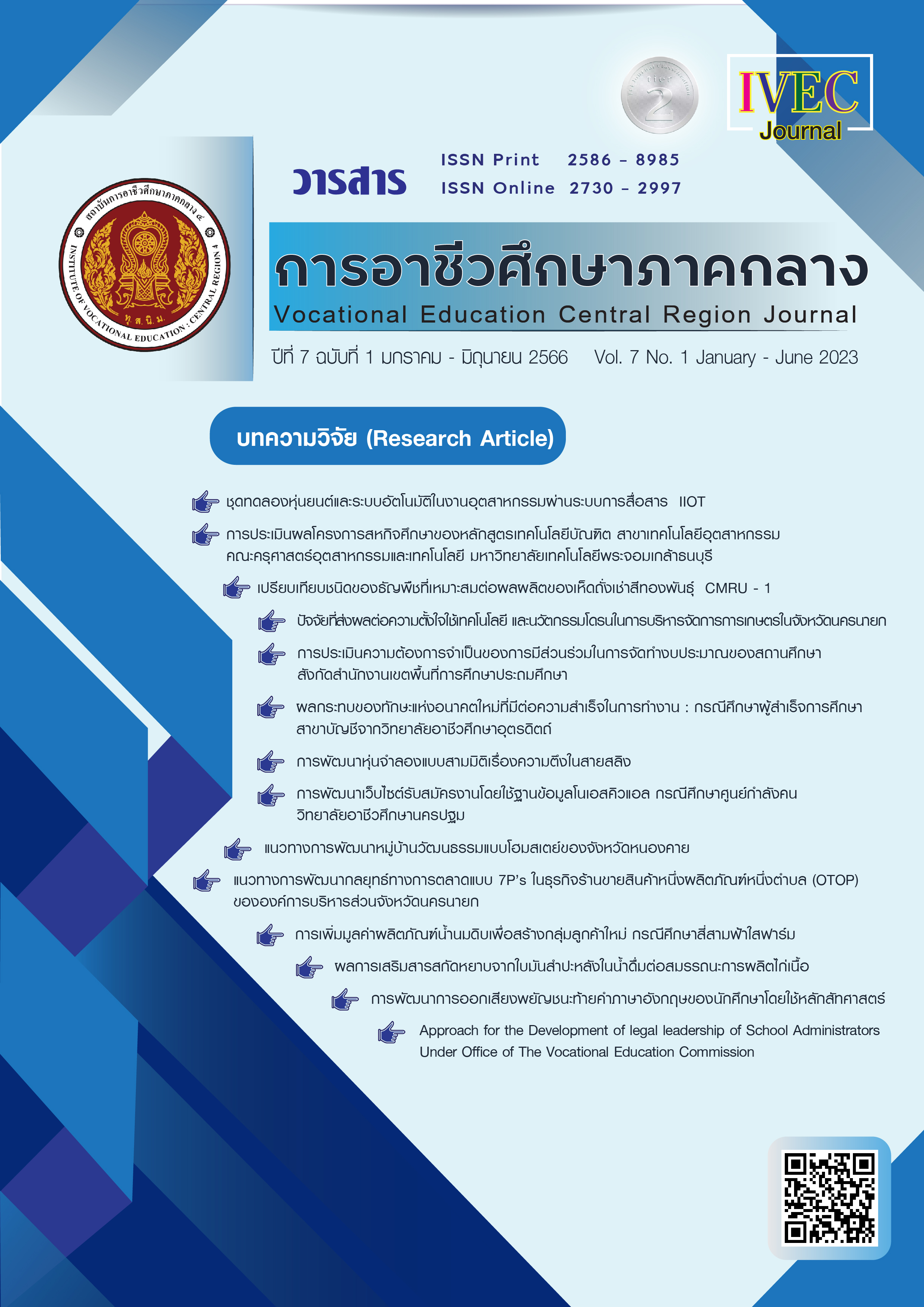การพัฒนาการออกเสียงพยัญชนะท้ายคำภาษาอังกฤษของนักศึกษาโดยใช้หลักสัทศาสตร์
Main Article Content
บทคัดย่อ
งานวิจัยนี้มีวัตถุประสงค์ 1) เพื่อพัฒนาการออกเสียงพยัญชนะท้ายคำภาษาอังกฤษของนักศึกษาโดยใช้หลักสัทศาสตร์ และ 2) เพื่อศึกษาผลสัมฤทธิ์ในการออกเสียงพยัญชนะท้ายคำภาษาอังกฤษโดยใช้หลักสัทศาสตร์ของนักศึกษาประชากรเป็นนักศึกษาชั้นปีที่ 2 คณะครุศาสตร์ สาขาวิชาภาษาอังกฤษ มหาวิทยาลัยราชภัฏกาญจนบุรี จำนวน 50 คน เครื่องมือที่ใช้ในการศึกษา ได้แก่ แบบฝึกและแบบทดสอบการออกเสียงพยัญชนะท้ายคำภาษาอังกฤษ กลุ่มเสียงเสียดแทรก (Fricatives ; / f / , / v / , / θ / , / ð / , / s / , / z / , / ʃ / , / ʒ / , / h / ) กลุ่มเสียงข้างลิ้น (Lateral ; / l / ) และกลุ่มเสียงกระดกลิ้น (Tap ; / r / ) การวิเคราะห์ข้อมูลใช้ค่าร้อยละเพื่ออธิบายผลการพัฒนาการออกเสียงพยัญชนะท้ายคำภาษาอังกฤษของนักศึกษาคะแนนเฉลี่ยและค่าส่วนเบี่ยงเบนมาตรฐานในการอธิบายผลสัมฤทธิ์ในการออกเสียงพยัญชนะท้ายคำภาษาอังกฤษ ก่อนและหลังเรียน ผลการศึกษาสรุปได้ ดังนี้ 1) การสอนการออกเสียงพยัญชนะท้ายคำภาษาอังกฤษ โดยหลักสัทศาสตร์ สามารถพัฒนาการออกเสียงที่ถูกต้องของนักศึกษาได้โดยพบว่านักศึกษาที่ผ่านการทดสอบการออกเสียงพยัญชนะท้ายคำภาษาอังกฤษมีจำนวนมากกว่าร้อยละ 80 กล่าวคือ นักศึกษาร้อยละ 84.00 ผ่านการทดสอบการออก เสียงพยัญชนะท้ายคำภาษาอังกฤษกลุ่มเสียงเสียดแทรก (Fricatives) กลุ่มเสียงข้างลิ้น (Lateral) และนักศึกษาร้อยละ 96 ผ่านการออกเสียงพยัญชนะท้ายคำภาษาอังกฤษ กลุ่มเสียงกระดกลิ้น (Tap) 2) จากการสอนการออกเสียงพยัญชนะท้ายคำภาษาอังกฤษโดยใช้หลักสัทศาสตร์ นักศึกษามีผลสัมฤทธิ์ในการออกเสียงพยัญชนะท้ายคำภาษาอังกฤษหลังเรียนสูงกว่าก่อนเรียน
Article Details

อนุญาตภายใต้เงื่อนไข Creative Commons Attribution-NonCommercial-NoDerivatives 4.0 International License.
|
บทความ ข้อมูล เนื้อหา รูปภาพ ฯลฯ ที่ได้รับการตีพิมพ์ในวารสาร การอาชีวศึกษาภาคกลาง ถือเป็นลิขสิทธิ์ของวารสารการอาชีวศึกษาภาคกลางหากบุคคลหรือหน่วยงานใดต้องการนำทั้งหมดหรือส่วนใดส่วนหนึ่ง ไปเผยแพร่ต่อหรือเพื่อกระทำการใด ๆ กองบรรณาธิการไม่สงวนสิทธิ์ ในการคัดลอกบทความเพื่อการศึกษาแต่ให้อ้างอิงแหล่งที่มาให้ครบถ้วน สมบูรณ์ สงวนสิทธิ์ โดย สถาบันการอาชีวศึกษาภาคกลาง 4 ที่ตั้ง 90 ถนนเทศา ตำบลพระปฐมเจดีย์ อำเภอเมือง จังหวัดนครปฐม โทรศัพท์ 034 242 856 , โทรสาร 034 242 858 ISSN : 3056-9176 (print) ISSN : 2985-2382 (online) |
เอกสารอ้างอิง
กมลเนตร ลีวาเมาะ. (2552). การวิเคราะห์ข้อผิดในการออกเสียงพยัญชนะภาษาอังกฤษของนักศึกษาสาขาวิชาภาษาอังกฤษเพื่อการสื่อสารสากล มหาวิทยาลัยเทคโนโลยีราชมงคลศรีวิชัย. รายงานการวิจัย คณะวิทยาศาสตร์และเทคโนโลยี มหาวิทยาลัยเทคโนโลยีราชมงคลศรีวิชัย.
ธัญลักษณ์ คำพรหม. (2561). การพัฒนาการออกเสียงคำภาษาอังกฤษที่สะกดด้วยพยัญชนะต้นที่ไม่มีในคำภาษาไทย โดยใช้แบบฝึกออกเสียงแบบคู่เทียบเสียง. รายงานวิจัย หลักสูตรภาษาอังกฤษเพื่อการสื่อสาระหว่างประเทศ วิทยาลัยนานาชาติ มหาวิทยาลัยราชภัฏเชียงใหม่.
นันทนา รณเกียรติ. (2555). สัทศาสตร์เพื่อการสอนการออกเสียงภาษาอังกฤษ. กรุงเทพฯ : มหาวิทยาลัยธรรมศาสตร์.
ปิยะวดี อภิชาตบุตร. (2554, กรกฎาคม - ธันวาคม). ปัญหาและแนวทางแก้ไขเสียงพูดภาษาอังกฤษของผู้เรียนคนไทยตามแนวสรีรสัทศาสตร์. วารสารดำรงวิชาการ, 10, (2), หน้า. 1 – 22
ศิริรัตน์ ชูพันธ์ อรรถพลพิพัฒน์. (2560, มกราคม-มิถุนายน). การออกเสียงพยัญชนะท้ายภาษาอังกฤษของนักศึกษามหาวิทยาลัยราชภัฏสุราษฎร์ธานี. วารสารมนุษยศาสตร์, 24, (1), หน้า. 222 - 250.
อรุณรัศมี แก้วลอย. (2555). การพัฒนาการออกเสียงพยัญชนะเสียงเสียดแทรกภาษาอังกฤษโดยวิธีสอนภาษาแบบฟัง - พูดและหลักการทางสรีรสัทศาสตร์. สารนิพนธ์ ปริญญาการศึกษามหาบัณฑิต สาขาวิชาภาษาศาสตร์การศึกษา บัณฑิตวิทยาลัย มหาวิทยาลัยศรีนครินทรวิโรฒ.
อาทิตย์ ถมมา. (2564). การวิเคราะห์การออกเสียงพยัญชนะท้ายคำภาษาอังกฤษเสียง / s / และ / ed / และกลวิธีการออกเสียงภาษาอังกฤษของนักศึกษาวิชาเอกภาษาอังกฤษธุรกิจชั้นปีที่ 1 มหาวิทยาลัยราชภัฏเลย : การวิเคราะห์ทางภาษาศาสตร์. ในการประชุมวิชาการระดับชาติราชภัฏเลยวิชาการครั้งที่ 7 (25 กุมภาพันธ์ หน้า 182 - 189). เลย : มหาวิทยาลัยราชภัฏเลย.
Dalton, D.F. (1997). Some Techniques for Teaching Pronunciation. Retrieved October 5, 2011, from http://iteslj.org/Techniques/Dalton-Pronunciation.html


